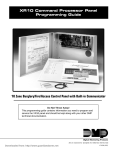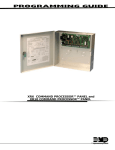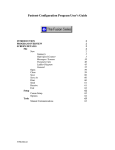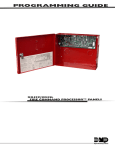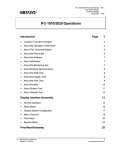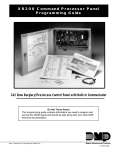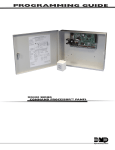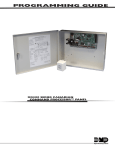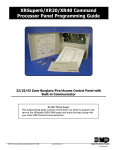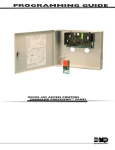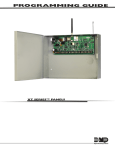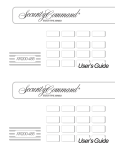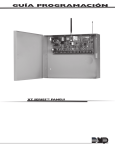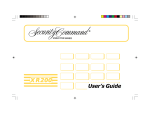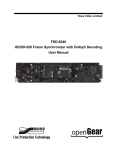Download MODEL 854/854A PROGRAMMING MANUAL - dmp.com
Transcript
MODEL 854/854A PROGRAMMING MANUAL 2500 N. Partnership Boulevard Springfield, MO 65803 www.dmpnet.com Digital Monitoring Products LT-0077(4/91) MODEL 854/854A PROGRAMMING MANUAL For use with DMP Series 1712 and 1812 Controls IMPORTANT When using the Series 1812 control for any UL, NFPA, CSFM or other listing organization's approved methods, see the UL Application Document provided with each 1812 control. This document outlines the installation and programming requirements for all applications for which the 1812 is approved. Copyright ©1986–1991 Digital Monitoring Products, Incorporated Information furnished by DMP is believed to be accurate and reliable. This information is subject to change without notice. TABLE OF CONTENTS Section INTRODUCTION ................................................................................................... 1.1 Programmer Installation .................................................................................. 1.2 Programmer Operation ................................................................................... 1.3 Special Keys ................................................................................................... 1.4 Entering Alpha Characters .............................................................................. 1.5 Entering Spaces with Alpha Characters .......................................................... 1.6 INITIALIZATION .................................................................................................... 2.1 Clear All Codes ............................................................................................... 2.2 Clear All Schedules ......................................................................................... 2.3 Clear Loop Information ................................................................................... 2.4 Clear Area Information .................................................................................... 2.5 COMMUNICATION Communication Type ...................................................................................... 3.1 Backup ............................................................................................................ 3.2 MPX Communication ...................................................................................... 3.3 Receiver Line Number .............................................................................. 3.5A Account Number ....................................................................................... 3.5B DD Communication ......................................................................................... 3.6 Account Number ....................................................................................... 3.6A First Telephone Number ........................................................................... 3.6B Second Telephone Number ...................................................................... 3.6C Automatic Recall Time ............................................................................. 3.6D SYSTEM REPORTS ............................................................................................. 4.1 Opening/Closing Reports ................................................................................ 4.2 Opening/Closing Reports to Operator ............................................................. 4.3 Abort Reports .................................................................................................. 4.4 Loop Restoral Reports .................................................................................... 4.5 Bypass Reports .............................................................................................. 4.6 Schedule Change Reports .............................................................................. 4.7 Code Change Reports .................................................................................... 4.8 Access Keypads ............................................................................................. 4.9 Ambush ........................................................................................................... 4.10 SYSTEM OPTIONS .............................................................................................. 5.1 All/Perimeter ................................................................................................... 5.2 Armed Display ................................................................................................. 5.3 Opening Code ................................................................................................. 5.4 Closing Code .................................................................................................. 5.5 Closing Wait .................................................................................................... 5.6 Closing Check ................................................................................................. 5.7 Any Bypass ..................................................................................................... 5.8 Entry Delay ..................................................................................................... 5.9 Exit Delay ........................................................................................................ 5.10 Loop Retard Delay .......................................................................................... 5.11 Power Fail Delay ............................................................................................. 5.12 Number of Devices ......................................................................................... 5.13 Swinger Bypass Trips ..................................................................................... 5.14 Reset Swinger Bypass .................................................................................... 5.15 Area Schedules ............................................................................................... 5.16 Relay Schedules ............................................................................................. 5.17 TABLE OF CONTENTS Section OUTPUT OPTIONS .............................................................................................. 6.1 Bell Cutoff Time .............................................................................................. 6.2 Automatic Bell Test ......................................................................................... 6.3 Bell Action ....................................................................................................... 6.4 Fire Type .................................................................................................. 6.4A Burglary Type ........................................................................................... 6.4B Supervisory Type ..................................................................................... 6.4C Panic Type ............................................................................................... 6.4D Emergency Type ...................................................................................... 6.4E Auxiliary Type 1 ........................................................................................ 6.4F Auxiliary Type 2 ........................................................................................ 6.4G Output Action .................................................................................................. 6.5 Cutoff Option ............................................................................................ 6.5A Cutoff Time ............................................................................................... 6.5A1 Communication Failure Output ................................................................. 6.5B Area Outputs ............................................................................................ 6.5C Fire Alarm Output ..................................................................................... 6.5C Fire Trouble Output .................................................................................. 6.5E MENU DISPLAY ................................................................................................... 7.1 Arm/Disarm ..................................................................................................... 7.2 Alarm Silence .................................................................................................. 7.3 Fire Reset ....................................................................................................... 7.4 Door Access ................................................................................................... 7.5 Armed Areas ................................................................................................... 7.6 Outputs On/Off ............................................................................................... 7.7 Loop Status ..................................................................................................... 7.8 Bypass Loops ................................................................................................. 7.9 Loop Monitor ................................................................................................... 7.10 System Status ................................................................................................ 7.11 System Test .................................................................................................... 7.12 User Codes ..................................................................................................... 7.13 Schedules ....................................................................................................... 7.14 Time ................................................................................................................ 7.15 Remote Authorization ..................................................................................... 7.16 STATUS LIST ....................................................................................................... 8.1 Display Keypads ............................................................................................. 8.2 System Monitor Troubles ................................................................................ 8.3 Fire Loops ....................................................................................................... 8.4 Burglary Loops ............................................................................................... 8.5 Supervisory Loops .......................................................................................... 8.6 Panic Loops .................................................................................................... 8.7 Emergency Loops .......................................................................................... 8.8 Auxiliary 1 Loops ............................................................................................ 8.9 Auxiliary 2 Loops ............................................................................................. 8.10 PRINTER REPORTS ............................................................................................ 9.1 Customer Name .............................................................................................. 9.2 Arm/Disarm Reports ....................................................................................... 9.3 Loop Reports .................................................................................................. 9.4 User Command Reports ................................................................................. 9.5 Door Access Reports ..................................................................................... 9.6 Supervisory Message Reports ........................................................................ 9.7 Printer Format ................................................................................................. 9.8 TABLE OF CONTENTS Section REMOTE OPTIONS ........................................................................................... 10.1 Remote Key .................................................................................................. 10.2 Manufacturer Authorization ........................................................................... 10.3 Armed Rings ................................................................................................. 10.4 Disarmed Rings ............................................................................................ 10.5 Alarm Receiver Authorization ....................................................................... 10.6 Service Receiver Authorization ..................................................................... 10.7 Remote Phone Number ................................................................................ 10.8 Remote Disarm ............................................................................................. 10.9 AREA INFORMATION ........................................................................................ 11.1 Area Number ................................................................................................ 11.2 Area Name .................................................................................................... 11.3 LOOP INFORMATION ........................................................................................ 12.1 Loop Number ................................................................................................ 12.2 Loop Name ................................................................................................... 12.3 Loop Type ..................................................................................................... 12.4 Loop Type Specifications ....................................................................... 12.4A Area Assignment .......................................................................................... 12.5 All, Perimeter .......................................................................................... 12.5A Area Number .......................................................................................... 12.5B Next Loop ..................................................................................................... 12.6 Alarm Action ................................................................................................. 12.7 Disarmed Open ............................................................................................. 12.8 Message To Transit ................................................................................ 12.8A Output Number ....................................................................................... 12.8B Output Action .......................................................................................... 12.8C Disarmed Short ............................................................................................. 12.9 Armed Open ................................................................................................. 12.9 Armed Short .................................................................................................. 12.9 Swinger Bypass ............................................................................................ 12.10 Prewarn Address .......................................................................................... 12.11 Retard ........................................................................................................... 12.12 Presignal Address ......................................................................................... 12.13 STOP ............................................................................................................... 13.1 SAVE INTO 854A ................................................................................................ 14.1 Save A, B or Stop ......................................................................................... 14.2 One Moment ................................................................................................. 14.3 Memory Checksum ....................................................................................... 14.4 LOAD INTO PANEL ............................................................................................ 15.1 Load A, B or Stop ......................................................................................... 15.2 Memory Checksum ....................................................................................... 15.3 COMPUTE CHECKSUM ..................................................................................... 16.1 Checksum for A, B Panel or Stop ................................................................. 16.2 Memory Checksum ....................................................................................... 16.3 APPENDIX B Backup when Main Communication is DD ...................................................... B.1 Backup when Main Communication is MPX ................................................... B.2 854/854A PROGRAMMER 1.1 1-INTRODUCTION Description This manual is a programming guide for the Model 1712 and 1812 COMMAND PROCESSOR controls. For technical specifications see the installation guide provided with each control. The Model 854/854A Programmer is used to enter system information into the DMP Series 1712 and 1812 COMMAND PROCESSORs. The 854/854A should not be used on any other COMMAND PROCESSOR series. Programming should always begin in section 2, Initialization. This programming section is used to clear the system memory in preparation for the custom information that you will enter. The Model 854 Programmer provides functions described in sections 2 through 13. The Model 854A Programmer provides all of the same functions plus sections 14, 15 and 16. The programming manual is written in the exact order of the programming steps of the Model 854/854A. Included with each COMMAND PROCESSOR are the Programming Information and Loop Information sheets. These sheets list the programming outline from start to finish. Before programming begins the information sheets should be filled out completely. The sheets can then be used for reference during programming. When programming is complete the Information sheets should be kept on file to provide a “blueprint” of the system. You should read the remainder of this introductory section for information on starting, using and stopping the Model 854/854A. 1.2 Programmer Installation The Series 1712 or 1812 COMMAND PROCESSOR should be completely installed and grounded before beginning programming. Power should be applied with the reset jumper (J13) placed in the R (reset) position. The Model 854/854A Programmer should then be installed on the PROGRAMMER CONNECTOR. DO NOT PLUG THE PROGRAMMER ONTO THE COMMUNICATION MODULE CONNECTOR! DAMAGE WILL RESULT! J13 Reset Position J13 Normal Operating Position R Programmer Connector R After the programmer is installed move J13 to the right hand position to start the programmer. Programming is done from SECURITY COMMAND address number 1. To remove the programmer, first place J13 in the reset position, then remove the programmer. Always place J13 in the reset position when installing orremoving the programmer. Page 1 1-INTRODUCTION 1.3 854/854A PROGRAMMER Programmer Operation When the programmer is installed and running, Security Command address number 1 will display the current firmware level of the programmer and the control panel to which it is attached. [854A-XXX PNL-YYY] XXX = The firmware level in the programmer YYY = The firmware level in the control panel Any control panel level prior to Level 200 will display the digit 5 or lower as the firmware level. This indicates that 100 level firmware is present. It is important to note that the programmer options intended for 1812/300 operation will not display on level 1812/200 firmware. Also, programmer options intended for 1812/200 operation will not display on level 1812 100 firmware. Below is an outline of the programmer options that are provided, and on which 1812 firmware level they function. By pressing the COMMAND key the display will begin stepping through the programming menu. There are sixteen programming sections that you will be selecting from. They are: Level Level 854A 1812/200 1812/300 Section Only Only Only Initialization 2 Communication 3 System Reports 4 System Options 5 Output Options 6 Menu Display 7 Status List 8 Printer Reports 9 YES YES Remote Options 10 YES Area Information 11 Loop Information 12 Stop 13 Save Into 854A 14 YES Load Into Panel 15 YES Compute Checksum 16 YES To select a section for programming you should press any one of the top row (select) keys when the name of that section is displayed. The detailed instructions for each programming step are in sections 2 through 17 of this manual. 1.4 Special Keys COMMAND The COMMAND key is used to step ahead in programming. It can go forward through the programming menu and through each step of a particular section. The COMMAND key is excellent for quickly stepping through a list of options to the one that you wish to program. During each programming step the display on the SECURITY COMMAND will show the current programming in the system memory. If the information is not to be changed you should press the COMMAND key to go forward to the next step. The COMMAND key is also used when entering information, such as phone numbers or loop names. Think of it as an enter key on a computer and press it when you have entered information on the keypad and you are ready for the SECURITY COMMAND to take it. Page 2 854/854A PROGRAMMER 1-INTRODUCTION The back arrow key is used for “backing up” during system programming. It can be pressed to back up through the programming menu or to back up a step within a section and reprogram an option that you may have just finished. The back arrow key is also used when an error is made while entering information on a particular option such as the automatic recall time or an area name. Press the back arrow and each character that you have entered will be erased one at a time. The top row of keys are called the select keys. Each time a select key is to be used its function will be labeled on the display above it. By labeling each key with the display they can be used for many different applications such as entering AM or PM when programming the automatic recall time or answering Yes or No for any one of the system options. The most important use of the select keys during programming is to change information in the system memory. Each step in programming will first display the current value stored in the memory. If this is to be changed a select key should be pressed. The display will then allow you to enter the new information. If it is a phone number or account number the information is entered by pressing the appropriate digit keys. I f however, the information to be programmed is the communication type or a yes, no response the select keys will be labeled with the valid range of responses. Sometimes more than four valid responses are avail able. In this case the display will list four at a time. You should press COMMAND to see the next four or the back arrow to review the previous four choices. The select keys are also used for selecting a section to program from the programming menu. This is done by pressing any one of the select keys when the name of the desired programming section is displayed. 1.5 Entering Alpha Characters Some entries during programming will require alpha characters, (letters of the alphabet). To enter alpha characters first press the key on which the desired letter appears. This will display the digit that appears on that key. To change the digit in the display to the desired letter press the top row select key that corresponds to the location of the letter on the key. The display will change to that letter. By pressing a different select key the letter will continue to change. When another digit key is pressed the letter is retained and the next character is displayed. Left Character Right Character Center Character 1.6 Entering Spaces With Alpha Characters To enter a space in an alpha entry you should press the 9 digit key followed by the third select key. The three characters on the 9 digit key are Y,Z and space. Page 3 2-INITIALIZATION 2.1 854/854A PROGRAMMER Description Initialization allows you to clear selected parts of the COMMAND PROCESSOR memory in preparation for system programming. There are four sections of the memory that can be cleared: Reference User Codes 2.2 Schedules 2.3 Loop Information 2.4 Area Information 2.5 After you select YES to clear a section of memory you will be asked if you are sure you want to clear the memory. This is a safeguard to keep from accidently erasing part of your programming. No memory will be cleared until you answer YES to the SURE? question. A description of each selection follows: 2.2 [CODES? [SURE? NO YES YES] NO ] CLEAR ALL CODES - When YES is selected the User Code memory is cleared and code number 99 is programmed into user number 99 position with access to all areas. 2.3 [SCHEDS? NO [SURE? YES YES] NO ] CLEAR ALL SCHEDULES - When YES is selected all output, temporary and permanent schedules will be cleared. 2.5 [LOOPS? [SURE? NO YES YES] NO ] CLEAR LOOP INFORMATION - When YES is selected the loop information for all loops will be cleared and all loops will be marked * UNUSED *. 2.5 [AREAS? [SURE? NO YES YES] NO ] CLEAR AREA INFORMATION - When YES is selected the area information for all areas will be cleared and all areas will be marked * UNUSED *. Page 4 854/854A PROGRAMMER 3-COMMUNICATION 3.1 Description Communication allows you to enter the communication information needed by the COMMAND PROCESSOR. The amount of information needed is dependent upon the type of communication you will be using. Therefore, the first specification to be made in COMMUNICATION is the type the system will be using. 3.2 [ COMM TYPE: [NONE 3.3 ???? ] DD MPX [ BACKUP NO ] YES ] COMMUNICATION TYPE specifies the type of communication module which will be used. The three communication types which are available are: NONE DD - MPX - For use in a local system. Do not install a communication module. Digital communication to the DMP SECURITY CONTROL receiver. Use Model 984-D communication module. Multiplex communication to the DMP SECURITY CONTROL receiver. Use Model 984-M communication module. Backup Communication allows for the use of a second communication module. If backup is selected YES the main communication module will be backed up in the following manner: MPX backed up with DD DD backed up with DD Appendix B fully describes the function of the backup communicator. 3.4 The remaining communication information that must be programmed will be dependent upon the type of communication that has been specified. Outlined below are the section numbers that contain the remaining programming instructions. Only the section numbers indicated should be studied for the desired communication. The others may be disregarded. 3.5 NONE - MPX DD - Communication Programming complete, no other information required. Section 3.5 Section 3.6 MPX If this is a MPX type communicating system an account number will be required. A Multiplex account number is made up of two parts, the receiver line number to which it communicates and the three digit account number of the control. After the type of communication has been entered in section 3.2 the display will show the current receiver line number in the system memory. 3.5A [ RECVR LINE NO.:? ] RECEIVER LINE NUMBER - This is the line number to which the control communicates on the DMP SECURITY CONTROL receiver. 3.5B [ ACCOUNT NO: ??? ] ACCOUNT NUMBER - The range of valid account numbers for MPX is zero to 127. This is the account number which is polled by the SECURITY CONTROL receiver. After the line number and the account number have been entered for a MPX type system the COMMUNICATION programming will terminate if backup was selected as NO in section 3.3. If backup was selected as YES the information in sections 3.6B to 3.6D must be programmed as well. Page 5 3-COMMUNICATION 3.6 854/854A PROGRAMMER DD If this is a DD type communicating system an account number, two phone numbers and an automatic recall time will be required. After backup communication has been selected in section 3.3 the display will show the current account number in the system memory. 3.6A [ ACCOUNT NO : ????? ] ACCOUNT NUMBER - The range of valid account numbers for DD is 1 to 65,535. This is the account number which will be transmitted to the DMP SECURITY CONTROL receiver. 3.6B [ FIRST PHONE NO. [??????? ] FIRST TELEPHONE NUMBER - The first telephone number is the number ] dialed on all communication to a central station receiver. It may be up to 15 characters in length. A three second pause may be entered in the dialing sequence by entering the letter P and a dial tone wait by entering the letter D. These characters must be counted in the total number of characters so as not to exceed 15. If a dial tone detect is entered it will cause the communication module to begin dialing as soon as dial tone is detected. The communication module will wait a maximum of five seconds for dial tone on the first attempt. If not detected it will hang up, then pick up the line again. After waiting another five seconds without dial tone it will begin dialing on the second through tenth attempts. 3.6C [ SECOND PHONE NO. ] SECOND TELEPHONE NUMBER - The second number will be dialed when [??????? ] two successive tries have failed on the first number. If two failures occur on the second phone number two more attempts will be made on the first. A total of ten dials will be made switching between first and second phone numbers. The number may be 15 characters in length and may include the P and D characters for pause and dial tone detect. 3.6 will [ AUTOMATIC RECALL ] AUTOMATIC RECALL TIME - This is the time each day when the system [ ?? : ?? [ - : ?M AM ] test communication to the central station by transmitting the Automatic Recall Message. A new time may be entered as follows: PM ] Example: if the new automatic recall time is 2:45 a.m. the following keys should be pressed: (0) (2) (4) (5) AM \__/ (__) If no automatic recall time is desired enter 15:00 p.m. After the automatic recall time is entered for a DD type system the COMMUNICATION programming will terminate. Page 6 854 /854A PROGRAMMER 4.1 4-SYSTEM REPORTS Description System Reports allows you to select which reports will be transmitted to a central station receiver. The reports which may be selected are: Reference Opening and Closing Reports 4.2 Opening and Closing Reports To Operator 4.3 Abort Reports 4.4 Loop Restoral Reports 4.5 Bypass Reports 4.6 Schedule Change Reports 4.7 Code Change Reports 4.8 Access Keypads 4.9 Ambush 4.10 A description of each report follows: 4.2 [ OPN / CLOS NO YES ] 4.3 [O/C OPER NO YES ] OPENING AND CLOSING REPORTS TO OPERATOR - When YES is selected each opening and closing report will be displayed on the DMP SECURITY CONTROL receiver CRT screen for operator acknowledgment in addition to being printed on the Activity Log. This option is displayed for selection only when Opening and Closing reports is selected as YES. 4.4 [ ABORT NO YES ] ABORT REPORT - When YES is selected an alarm abort report will be transmitted any time a burglary alarm has been transmitted and the system is disarmed while the alarm bell is still sounding. 4.5 [ LP RSTRL NO YES ] LOOP RESTORAL REPORT - When YES is selected loop restorals will be transmitted. The report includes the loop number, name and condition. 4.6 [ BYPASS NO YES ] BYPASS REPORTS - When YES is selected all loop bypasses and resets will be transmitted. The report includes the loop number and name and the user number of the individual operating the system. 4.7 [ SCHD CHG NO YES ] SCHEDULE CHANGE REPORTS - When YES is selected all permanent and temporary schedule changes will be transmitted. The report includes the day, opening time, closing time and the user number making the change. 4.8 [ CODE CHG NO YES ] CODE CHANGE REPORTS - When YES is selected all code additions and deletions will be transmitted. The report includes the user number added or deleted and the user number making the change. 4.9 [ ACS KEY : 12345678 ] ACCESS KEYPADS - This specifies the SECURITY COMMAND addresses that will transmit door access reports. A report will be transmitted on each door access made from the selected keypads. Addresses not selected will not transmit, however the door strike relay WILL function. The report includes the user number and the SECURITY COMMAND address which was used. 4.10 [ AMBUSH NO YES ] OPENING AND CLOSING REPORTS - When YES is selected a report is communicated each time an area is armed or disarmed. The report includes the area number and name and the user number of the individual operating the system. AMBUSH- When YES is selected an ambush report will be transmitted anytime user number one's code number is entered. When NO is selected, no ambush report will be sent and user number one will operate the same as all other codes. Page 7 5-SYSTEM OPTIONS 5.1 854/854A PROGRAMMER Description System Options allows your to select system wide parameters which will be used in the operation of the system. The options which must be specified are: All/Perimeter Armed Display Opening Code Closing Code Closing Wait Closing Check Any Bypass Entry Delay Exit Delay Loop Retard Delay Power Fail Delay Number Of Devices Swinger Bypass Trips Reset Swinger Bypass Area Schedules Relay Schedules Reference 5.2 5.3 5.4 5.5 5.6 5.7 5.8 5.9 5.10 5.11 5.12 5.13 5.14 5.15 5.16 5.17 A description of each System Option follows: 5.2 [ ALL/PRM 5.3 [ ARM DSPY NO 5.4 [ OPN CODE NO YES ] OPENING CODE - When YES is selected a code number will be required for disarming regardless of any temporary or permanent schedule. If NO is selected, a code number is not required for disarming during a scheduled period. 5.5 [ CLS CODE NO Page 8 NO YES ] ALL/PERIMETER - When YES is selected the system will operate according to the All/Perimeter Arming System User’s Guide. Only two burglary areas will exist, Perimeter and Interior. This type of system is referred to as an All/Perimeter System. When NO is selected the system will operate according to the Area Arming System User’s Guide. Up to eight independent burglary areas may be used. This type of system is referred to as an Area System. YES ] ARMED DISPLAY - When YES is selected the armed area status will be displayed on all SECURITY COMMANDS. It will be displayed when the SECURITY COMMAND display is not performing any other function. This could be right after system arming or disarming is complete or just after the user has finished using a menu option. The SECURITY COMMAND will stay in the Armed Display until the user chooses to go to system arming/disarming or a menu option. Armed Display will alternate with Status List if selected, see section 8. If the system is an All/Perimeter System the display will read “ON” when any area is armed. If the system is an Area System the display will show the area number if that area is armed, “1 2 3 4 5 6 7 8”. In both systems the display will remain blank if all areas are disarmed. YES ] CLOSING CODE - When YES is selected a code number will be required for system arming. If NO is selected a code number is not required for system arming. 854/854A PROGRAMMER 5.6 [ CLS WAIT 5.7 [ CLS CHK 5.8 [ ANY BYPS 5.9 [ ENTRY DELAY : ? ? ? ] ENTRY DELAY - This is the entry delay time assigned to all Exit Type Loops. When an armed Exit Type Loop is opened or shorted the prewarn tone will begin sounding and “ENTER CODE:-” will display immediately on all SECURITY COMMANDs chosen to prewarn for that loop. The system must be disarmed before the delay expires or an alarm will be transmitted. The Entry Delay can be from zero to 250 seconds. 5.10 [ EXIT NO 5-SYSTEM OPTIONS NO YES ] CLOSING WAIT - When YES is selected the SECURITY COMMAND will wait for an acknowledgment from the central station receiver before displaying the “ SYSTEM ON ” message during arming. Exit delays will be extended during this period and the display will read “ONE MOMENT...”. Opening and Closing Reports, section 4.2, must be selected as YES to allow Closing Wait to function. YES ] CLOSING CHECK - When YES is selected the SECURITY COMMAND will check to see that all areas of the system are armed. This check will be made after temporary or permanent schedules have expired, every hour at one minute past the hour. If the Closing Check finds any areas that are disarmed past the scheduled time the SECURITY COMMANDs selected to display System Trouble Status, (see section 8.2), will emit a steady beep and display “CLOSING TIME!” along with any other status messages. If multiple area achedules have been selected in section 5.16 the appropriate area name will be displayed followed by - LATE. The beep is silenced by pressing any top row key. If the system is not armed or a temporary schedule extended by five minutes past the hour the No Closing Report will be transmitted to the central station receiver. NO YES ] ANY BYPASS - When YES is selected loops may be bypassed without a code number during the arming sequence. A code number is always required to use the Bypass Loops menu option. DELAY : ? ? ? ] EXIT DELAY - This is the exit delay time assigned to all Exit Type Loops. When the loop is armed all activity on that loop will be ignored until the Exit Delay expires. This delay countdown is displayed on the SECURITY COMMAND. If an Exit Type Loop is in a bad condition at the end of the Exit Delay the Entry Delay will begin immediately. The Exit Delay can be from zero to 250 seconds. 5.11 [ RETARD DELAY : ? ? ? ] LOOP RETARD DELAY - This is the retard time which can be assigned to Fire, Supervisory, Auxiliary 1 and Auxiliary 2 type loops. The Retard Delay only functions in the short conditions. The loop must remain in the short condition for the entire length of the Retard Delay before the short conditio will be recognized by the alarm system. The Loop Retard Delay can be from zero to 250 seconds. 5.12 [ PWR FAIL HRS : ? ] POWER FAIL DELAY - This is used to time the duration of an A.C. power failure. The A.C. power must remain off for the entire length of the delay before an A.C. power failure message is transmitted to the central station receiver. The delay can be from zero to 9 hours. 5.13 [ NO. OF DEVICES : ? ] NUMBER OF DEVICES - This is the total number of SECURITY COMMAND keypads and Loop Expanders that will be used in the system. A Maximum of eight devices may be used. Page 9 5-SYSTEM OPTIONS 854/854A PROGRAMMER 5.14 [ SWGRBYPS TRIPS : ? ] SWINGER BYPASS TRIPS - This is the number of times that a loop can go into an alarm or trouble condition in one hour before being automatically bypassed. The hour timer starts the first time the loop trips. If the hour timer expires before the trip counter is exceeded the trip counter will return to zero. The next time the loop trips the hour counter will start again. If the trip counter is exceeded within the hour the loop will be automatically bypassed. A report of the automatic bypass will be transmitted if Bypass Reports has been selected as YES, see section 4.6. Bypassed loops are automatically reset when they are disarmed. All 24 hour loops are reset when any area of the system is disarmed. Swinger Bypass Trips can be from zero to seven. If zero is entered Swinger Bypass will not function. 5.15 [ RST SBYP NO YES ] RESET SWINGER BYPASS - When YES is selected an automatically bypassed loop will be automatically reset if it remains in a normal condition for one hour. A report of the automatic reset will be transmitted if Bypass Reports has been selected as YES, see section 4.6. 5.16 [ AREA SCHEDULES: ? ] AREA SCHEDULES - This is the number of permanent and temporary area opening/closing schedules that will be utilized. The valid selections are 1, 4 or 8. If 1 is selected, the end user may enter one permanent and temporary schedule of the entire system. If 4 is selected a separate set of schedules will exist for the first four areas. Areas 5 to 8 will have no schedule. If 8 is selected all areas will have an independent permanent and temporary schedule. If 4 is selected the memory area for relay schedules 9 to 16 will be used to store the four area schedules. If 8 is selected, the memory area for all of the relay schedules will be used. If 4 or 8 is selected the closing check option in section 5.7 will be reported by area number to the central station. Level 1812/303 firmware is required in the control panel and SCS1/610 is required in the receiver in order for this option to function. 5.17 [ RELAY SCHD NO YES ] RELAY SCHEDULES - When YES is selected the dry contact relays will function according to the permanent and temporary schedules entered in section 5.16. The schedule/relay relationships are shown below: IF 4 AREA SCHEDULES SCHED PERM TEMP PERM TEMP PERM TEMP PERM TEMP AREA 1 1 2 2 3 3 4 4 RELAY 9 10 11 12 13 14 15 16 IF 8 AREA SCHEDULES SCHED PERM TEMP PERM TEMP PERM TEMP PERM TEMP AREA 1 1 2 2 3 3 4 4 RELAY 1 2 3 4 5 6 7 8 SCHED PERM TEMP PERM TEMP PERM TEMP PERM TEMP AREA 5 5 6 6 7 7 8 8 RELAY 9 10 11 12 13 14 15 16 If NO is selected, the dry contract relay will not function from any schedule. Manual or loop activation will still be operational. Page 10 854/854 PROGRAMMER 6.1 6-OUTPUT OPTIONS Description Output Options allows you to program the Bell Output functions and certain Dry Contact Relay Output options. The specifications to be made are: Bell Cutoff Time Automatic Bell Test Bell Action for Fire Loops Burglary Loops Supervisory Loops Panic Loops Emergency Loops Auxiliary 1 Loops Auxiliary 2 Loops Output Action for . . . Cutoff Output Cutoff Time Communication Fail Output Area Outputs Fire Alarm Output Fire Trouble Output Reference 6.2 6.3 6.4 6.4A 6.4B 6.4C 6.4D 6.4E 6.4F 6.4G 6.5 6.5A 6.5A1 6.5B 6.5C 6.5D 6.5E A description of each Output Option follows: 6.2 [ BELL CUTOFF : 6.3 [ BELL TST NO ? ? ] BELL CUTOFF TIME - This is the maximum delay time the Bell Output will remain on before being automatically silenced. If the Bell Output is manually silenced the cutoff time is reset. The Bell Cutoff Time can be from zero to 99 minutes. If zero is entered the bell cutoff will not function. YES ] AUTOMATIC BELL TEST - When YES is selected the Bell Output will be turned on for two seconds each time the system is completely armed. 6.4 [ BELL ACTION . . . . . ] Bell Action defines the condition that the Bell Output will be placed in when a loop goes into an ALARM condition. TROUBLE conditions do not activate the Bell Output. Each of the seven loop types can be programmed individually for Bell Action. To place the Bell Output in a steady condition enter S. To place the Bell Output in a pulse condition, enter P. If no Bell Action is desired enter N. The seven loop types which are programmed are: 6.4A [ FIRE TYPE : ? ] FIRE TYPE - Defines Bell Action for Fire Type Loops 6.4B [ BURGLARY TYPE : ? ] BURGLARY TYPE - Defines Bell Action for Burglary Type Loops 6.4C [ SUPRVSRY TYPE : ? ] SUPERVISORY TYPE - Defines Bell Action for Supervisory Type Loops 6.4D [ PANIC PANIC TYPE - Defines Bell Action for Panic Type Loops TYPE : ? ] 6.4E [ EMERGNCY TYPE : ?] EMERGENCY TYPE - Defines Bell Action for Emergency Type Loops 6.4F [ AUXLRY 1 TYPE : ? ] AUXILIARY 1 TYPE - Defines Bell Action for Auxiliary 1 Type Loops 6.4G [ AUXLRY 2 TYPE : ? ] AUXILIARY 2 TYPE - Defines Bell Action for Auxiliary 2 Type Loops Page 11 6-OUTPUT OPTIONS 854/854A PROGRAMMER 6.5 [ OUTPUT ACTION . . ] Output Action defines six options which can be assigned to the Dry Contact Relay Outputs. If any require the use of relay outputs nine to 16 the Model 864 Relay Expansion Module must be added to the Model 1712 or 1812. 6.5A [ CUTOFF OUTPUT: ??] CUTOFF OUTPUT - Any one Dry Contact Relay Output may be programmed to turn off after a specified delay. Any relay output from one to 16 may be used. If this option is not desired enter zero. 6.5A1 [ CUTOFF TIME: ??] CUTOFF TIME - If a cutoff output is assigned above then the cutoff delay time will be requested. This is the maximum time the cutoff relay will remain on before being automatically turned off. If the output is manually silenced the cutoff time is reset. The Cutoff Time can be from zero to 99 minutes. If zero is entered the relay cutoff will not function. 6.5B [ COMM FAIL OUT: ??] COMMUNICATION FAILURE OUTPUT - This relay output will be turned on any time a DD communicating system fails to communicate with the central station receiver on three successive dial attempts. The relay is activated at the beginning of the fourth dial. This relay output will also be turned on when a MPX communicating system does not communicate with the receiver for 150 seconds or if the backup communication module has transmitted a message. This relay output is turned off automatically when the system is disarmed. Any relay output from one to 16 may be used. If this option is not desired enter zero. 6.5C [ AREA OUT NO YES ] AREA OUTPUTS - When YES is selected the armed condition of areas one through eight will be indicated on relay outputs nine through 16 respectively. If the area is armed the relay will be turned on. This option requires the use of the Model 1812E Command Processor or the addition of the Model 864 Relay Expansion Module to the Model 1712 Command Processor. This option functions with both the Area and All/Perimeter Systems. For All/Perimeter systems area 1 is the perimeter and area 2 is the interior. The relay outputs used for armed area indications must not be used for any other purpose. Any unused relay outputs not being used for area indication may be used for any other option. 6.5D [ FIRE ALRM OUT : ? ? ] FIRE ALARM OUTPUT - This relay output will be turned on any time a fire type loop is placed in the alarm condition. The relay is turned off when the Fire Reset option is performed and no fire type loops are in the alarm condition. 6.5E [ FIRE TRBL OUT : ? ? ] FIRE TROUBLE OUTPUT - This relay output will be turned on any time a fire type loop is placed in the trouble condition or when a supervisory type loop is placed in the alarm or trouble condition. The relay is turned off when all fire and supervisory type loops are restored. Page 12 854/854A PROGRAMMER 7.1 7-MENU DISPLAY Description Menu Display allows you to select which Menu options will be displayed on the SECURITY COMMAND keypads. The Menu Options which are available are: Arm/Disarm Alarm Silence Fire Reset Door Access Armed Areas Outputs On/Off Loop Status Bypass Loops Loop Monitor System Status System Test User Codes Schedules Time Remote Authorization Reference 7.2 7.3 7.4 7.5 7.6 7.7 7.8 7.9 7.10 7.11 7.12 7.13 7.14 7.15 7.16 A description of each Menu Option follows: 7.2 [ ARM / DIS NO YES ] ARM/DISARM allows the subscriber to arm and disarm the areas in a burglary system. 7.3 [ ALM SLNC NO YES ] ALARM SILENCE allows the subscriber to silence the bell output. 7.4 [ FIRE RST 7.5 [ DOOR ACS NO 7.6 [ ARM AREA NO YES ] ARMED AREAS allows the subscriber to display a list of the armed areas in the system. Each area is displayed with name and number. 7.7 [ OUTPUTS NO YES ] OUTPUTS ON/OFF allows the subscriber to manually control the dry contact relay outputs. 7.8 [ LP STATS NO YES ] LOOP STATUS allows the subsciber to display a list of armed, bypassed, or alarmed loops; or will check the status of an individual loop. 7.9 [ BYPAS LP NO YES ] BYPASS LOOPS allows the subscriber to bypass individual loops out of the alarm system. It is also used to reset a bypassed loop back into the alarm system. A bypassed loop is automatically reset each time it is disarmed. 7.10 [ LOOP MON NO YES ] FIRE RESET allows the subscriber to reset smoke detectors. The smoke detector output will be turned off for five seconds and then turned back on. This function also clears fire and supervisory type loops from status list. YES ] NO YES ] DOOR ACCESS allows the subscriber to activate the door strike relay on a SECURITY COMMAND keypad. The door strike relay will turn on for five seconds. See the SECURITY COMMAND installation guide for details about which SECURITY COMMAND Models provide a door strike relay. LOOP MONITOR - allows the subscriber to monitor selected disarmed loops and display their name when tripped. Page 13 7-MENU DISPLAY 854/854A PROGRAMMER 7.11 [ SYS STATS NO YES ] SYSTEM STATUS allows the subscriber to display the status of the internal system monitors. The monitors are the bell circuit, AC power, battery power, bell fuse, panel tamper, auxiliary power fuse and the ground circuit. 7.12 [ SYS TEST NO YES] SYSTEM TEST allows the subscriber to test the bell circuit, battery and communication to the central station. The test results are displayed after each test. 7.13 [ USR CODE NO YES] USER CODES allows the subsciber to add and delete user codes in the system memory. 7.14 [ SCHEDULS NO YES] SCHEDULES allows the subsciber to enter daily on and off times for the d ry contact relay outputs plus temporary and permanent opening and closing schedules. 7.15 [ TIME NO YES ] TIME allows the subsciber to display the current day of the week, time of day and date of year. 7.16 [ RMT AUTH NO YES] REMOTE AUTHORIZATION - When YES is selected the end user will be required to enter a level 8 code from the Remote Authorization menu option before any remote commands or programming can be done. Each end user authorization will expire within one hour. If NO is selected Remote Authorization will not be displayed in the end user menu and it will not be required prior to performing remote commands or programming. Page 14 854/854A PROGRAMMER 8.1 8-STATUS LIST Description Status List allows you to select the loop alarms and troubles, and system monitor troubles that will be listed on the SECURITY COMMAND display. The Status List function will operate automatically for the end user when the SECURITY COMMAND is not performing any other function. This could be right after system arming or disarming is complete or just after the user has finished using a menu option. The SECURITY COMMAND will stay in the Status List until the user chooses to go to system arming/disarming or a menu option. Status List will alternate with Armed Display if selected, see section 5.3. You can choose to have System Monitor troubles placed in the list, the different loop types which will be placed in the list and at which SECURITY COMMAND addresses they will be displayed. The selections to be made while programming are: Display Keypads System Monitor Troubles Fire Loops Burglary Loops Supervisory Loops Panic Loops Emergency Loops Auxiliary 1 Loops Auxiliary 2 Loops Reference 8.2 8.3 8.4 8.5 8.6 8.7 8.8 8.9 8.10 A description of how each will be displayed in the Status List follows: 8.2 [ DISPLAY KEYPADS : ] The Display Keypads section will define which SECURITY COMMAND addresses will display the various status information. Any combination of addresses may be entered in the various status items that follow. If a particular status item is not desired for display, do not enter any addresses. 8.3 [ SYS TRB 12345678 ] SYSTEM MONITOR TROUBLES - Specifies the addresses where any trouble on a System Monitor will be displayed. The System Monitors are: Bell Circuit A.C. Power Battery Power Bell Power Fuse Panel Box Tamper Auxiliary Power Fuse Ground Circuit The name of the System Monitor will be placed in the Status List and the keypad steady trouble buzzer will sound. The buzzer will remain on until the monitor restores or any top row key is pressed on the keypad. The name will remain in the list until the condition is restored. 8.4 [ FIRE 12345678 ] FIRE LOOPS - Specifies the addresses where all fire loop alarms and troubles will be placed in the Status List. The loop name will be displayed and if it is a trouble the keypad steady trouble buzzer will sound. The buzzer will remain on until any top row key is pressed on the keypad. The name will re main in the list until it is cleared by Fire Reset menu option. Page 15 8-STATUS LIST 854/854A PROGRAMMER 8.5 [ BURG 12345678 ] BURGLARY LOOPS - Specifies the addresses where all burglary loop alarms and troubles will be placed in the Status List. Burglary loops include Night, Day, and Exit type loops. If it is a trouble the name will remain in the list until the loop is restored. If it is an alarm, only the last burglary loop which is tripped will remain in the list, and the alarm name will remain in the list until another burglary loop goes into alarm or any area of the system is disarmed. This is to insure that if a burglary is in progress the last loop which was tripped will remain in the list even if the loop has been restored. This burglary position in the Status List is shared with The Loop Monitor menu option, (see Loop Monitor in the User’s Manual). The keypad buzzer will sound for one second on burglary alarms. 8.6 [ SPVSY 12345678 ] SUPERVISORY LOOPS - Specifies the addresses where all supervisory loop alarms and troubles will be placed in the status list. The function of supervisory loops in the status list is the same as fire type loops. 8.7 [ PANIC 12345678 ] PANIC LOOPS - Specifies the addresses where all panic loop alarms and troubles will be placed in the status list. The name of the loop will remain in the list until the loop restores. The keypad buzzer will not sound for panic alarms or troubles. 8.8 [ EMERG 12345678 ] EMERGENCY LOOPS - Specifies the addresses where all emergency loop alarms and troubles will be placed in the status list. The name of the loop will remain in the list until the loop restores. The keypad buzzer will not sound for emergency alarms or troubles. 8.9 [ AUX 1 12345678 ] AUXILIARY 1 LOOPS - Specifies the addresses where all auxiliary 1 loop alarms and troubles will be placed in the status list. The name of the loop will remain in the list until the loop restores. The keypad buzzer will not sound for auxiliary 1 alarms or troubles. 8.10 [ AUX 2 12345678 ] AUXILIARY 2 LOOPS - Specifies the addresses where all auxiliary 2 loop alarms and troubles will be placed in the status list. The name of the loop will remain in the list until the loop restores. The keypad buzzer will not sound for auxiliary 2 alarms or troubles. Page 16 854/854A PROGRAMMER 9-PRINTER REPORTS 9.1 Printer Reports allows you to select which reports will be printed via the Model 868 Local Printer Interface. The reports which may be selected are: Customer Name Arm/Disarm Reports Loop Reports User Command Reports Door Access Reports Supervisory Reports Printer Format Reference 9.2 9.3 9.4 9.5 9.6 9.7 9.8 A description of each report follows: 9.2 [CUSTOMER NAME? ] CUSTOMER NAME - This is a 16 character field where the end user’s company name should be entered. This name will be printed at the top of each page. 9.3 [ARM/DIS NO YES] ARM/DISARM REPORTS - When YES is selected a report is printed each time an area is armed or disarmed. The report includes area number, area name and user number. 9.4 [LOOP NO YES] LOOP REPORTS - When YES is selected a report is printed for all loop status changes. This includes alarms, troubles, restorals, bypasses and resets. The report includes the loop name and number. 9.5 [USR CMDS NO YES] USER COMMANDS - When YES is selected a report is printed for the various user functions. This includes alarm silence, fire reset, outputs on/off, bypass loops, loop monitor, system test, user codes, schedules, time and remote authorization. The user number is printed with each report. 9.6 [DOOR ACS NO YES] DOOR ACCESS REPORTS - When YES is selected a report is printed for each door access from all Security Command addresses. The user number is printed with each report. 9.7 is [SUPV MSG NO YES] SUPERVISORY MESSAGE REPORTS - When YES is selected a report printed for supervisory messages. This includes all system monitors, closing time and abort. 9.8 Printer Format The printer output will format each page of a standard 81/2 x11 form. The company name, day of week, date and page number will appear at the top of each page. Four column headings will also be printed. An example of each page header is shown below. COMPANY NAME TUESDAY DESCRIPTION 3/15/89 ACTION PAGE 7 USER TIME At the end of each day, the end of day message will be printed and the page number will be reset. Page 17 10-REMOTE OPTIONS 854/854A PROGRAMMER 10.1 Remote Options allows you to enter the information needed for Remote Command/Remote Programming operation. The options which must be specified are: Remote Key Manufacturer Authorization Armed Number of Rings Disarmed Number of Rings Alarm Receiver Authorization Service Receiver Authorization Remote Phone Number Remote Disarm Reference 10.2 10.3 10.4 10.5 10.6 10.7 10.8 10.9 A description of each Remote Option follows: 10.2 [RMT KEY: ******** ] REMOTE KEY - This eight digit code is used by the control panel to verify communication from the receiver. The remote command / programming receiver must give the correct key to the control panel before any remote functions are allowed. The existing key is never displayed by the programmer. All controls are shipped from the factory with the key blank. SIMS Version 3 software keeps a file for each key by account number at the central station. 10.3 [MFG AUTH NO YES] MANUFACTURER AUTHORIZATION - When YES is selected DMP service technicians can access the control panel to aid in system service or troubleshooting. This authorization automatically expires within one hour. DMP remote service is provided on a “read only” basis. DMP technicians can look at the system programming and make suggestions but any alterations must be accomplished locally by the installing company's service personnel. 10.4 [ARM RINGS:?? ] ARMED RINGS - This is the number of rings that the control panel will count before answering the phone line while all areas of the system are armed. Any number from 1 to 15 may be entered. If zero is entered the phone line will not be answered when any area of the system is armed. A Series 984 Communication Module with ring detect, such as the Model 984D1 or D2, is required for this option. 10.5 [DISARM RINGS:?? ] DISARMED RINGS - This is the number of rings that the control panel will count before answering the phone line while any areas of the system are disarmed. Any number from 1 to 15 may be entered. If zero is entered the phone line will not be answered when any area of the system is disarmed. A Series 984 Communication Module with ring detect, such as the Model 984D1 or D2, is required for this option. 10.6 [ALR RCVR NO YES] ALARM RECEIVER AUTHORIZATION - When YES is selected remote commands and programming will be accepted from the main central station receiver system. Other authorization such as end user remote authorization and remote key may also be required. When NO is selected remote functions will not be accepted from the main central station receiver system. Page 18 854/854A PROGRAMMER 10.7 [SVC RCVR NO 10-REMOTE OPTIONS YES] SERVICE RECEIVER AUTHORIZATION - When YES is selected remote commands and programming will be accepted from a secondary service receiver system other than the main central station receiver. Other authorizations such as end user remote authorization and remote key may also be required. When NO is selected remote functions will not be accepted from a secondary service receiver system. 10.8 [REMOTE PHONE NO.] [??????? ] REMOTE PHONE NUMBER - This is the phone number that the control panel will dial when remote programming is requested. If a phone number is entered the control panel will allow remote commands and programming only after it has been called by the authorized receiver, disconnected and has redialed the remote phone number. If no number is entered the control panel will allow remote functions without having to disconnect and redial. The phone number may be 15 digits in length. Enter D for dial tone detect and P for a 3 second pause. 10.9 [DISARM NO REMOTE DISARM - When YES is selected the system may be disarmed remotely. When NO is selected disarming remotely will not be allowed. YES] Page 19 11-AREA INFORMATION 854/854A PROGRAMMER 11.1 Description Area Information allows you to assign names to the different areas in an Area Arming System. If the system is an All/Perimeter System, Area Information programming is not necessary. The non-24 hour loops which are programmed in section 12. Loop Information, must be assigned to an active area. An area is activated when it is given a name. An Area Arming System may have up to eight independent areas. A name is given to each active area to be displayed to the user in the various arming and disarming procedures so that the user will not be required to memorize area numbers but can associate a name with a particular area of the system. 11.2 Entering the area names is a two step process. First you must enter the area number that is to be named and then enter the name: [ AREA NO :- 11.3 [ NAME:?????????? ] AREA NUMBER - Enter the area number that you want to name. An area arming system can have eight independent areas. ] AREA NAME - The Area Name can be up to 10 alphanumeric characters. After the name is entered the display will return for the next area number to be named. It is important to note that only areas that will have loops assigned to them should be given names. All others should be marked unused. To mark an area unused delete the old name and press COMMAND when the display is requesting a new name. The programmer will automatically program the name as "* UNUSED *". If you have already cleared Area Information during Initialization, Section 2.5, the areas will already be marked "* UNUSED *". Page 20 854/854A PROGRAMMER 12-LOOP INFORMATION 12.1 Description Loop Information allows you to define the operation of each protection loop that is going to be used in the system. All protection loops, whether located on the COMMAND PROCESSOR or SECURITY COMMANDs, are programmed the same way. The specifications that must be made for each loop are: Reference Loop Number 12.2 Loop Name 12.3 Loop Type 12.4 Area Assignment 12.5 Alarm Action 12.7 A description of each specification follows: 12.2 [ LOOP NO : - ] LOOP NUMBER - Enter the loop number that you want to define. 12.3 [ NAME : ?????????? ] LOOP NAME - The loop name can have up to 10 alphanumeric characters. A name is given to each loop that will be used in the system. It can then be displayed to the user in the various arming and disarming procedures so that the user will not be required to memorize loop numbers but can associate a name with a particular protection point. A loop that is not part of the system should be marked unused. To mark a loop unused delete the old name and press COMMAND when the display requests the new name. The programmer will automatically program the name as “ * UNUSED * ". If you have already cleared Loop Information during Initialization, Section 2.4, the loops will already be marked “* UNUSED *”. 12.4 [ LOOP TYPE : ???? LOOP TYPE - The Loop Type defines what action should be taken by the COMMAND PROCESSOR when the loop is tripped. This is called the Alarm Action. There are eight different specifications which can be made by the Alarm Action. Reference Disarmed Open 12.8 Disarmed Short 12.9 Armed Open 12.9 Armed Short 12.9 Swinger Bypass 12.10 Prewarn Address 12.11 Retard 12.12 Presignal Address 12.13 ] By selecting the Loop Type all of the specifications will be made automatically for the loop. There are ten different Loop Types available. Each one defines the Alarm Action in a different way. Not all of the eight specifications are made for each type. Example: The Fire Type Loop does not have a specification for Disarmed Open or Short. This is because the Fire Type Loop is a 24 hour loop. The functional details of each specification are not discussed here, they are fully described in sections 12.7 through 12.13. To enter a new Loop Type Press DELETE and the display will list the available Loop Types four at a time. [ — [ FI [ A1 NT PN A2 DY EM EX SV ] ] ] Blank, Night, Day, Exit Fire, Panic, Emergency, Supervisory Auxiliary 1, Auxiliary 2 Press the key beneath the desired type when it is displayed. The chart on the next page gives a detailed outline of each Alarm Action for each Loop Type. Page 21 12-LOOP INFORMATION 854/854A PROGRAMMER 12.4A LOOP TYPE SPECIFICATIONS BLANK Specifing a loop type as blank leaves the current Alarm Action programming the same, but no loop type message will be communicated. Use only with SECURITY CONTROL Receiver. Alarm Action: Disarmed Open: Disarmed Short: Armed Open: Armed Short: Swinger Bypass: NIGHT A T(-) Output A T(-) Output (A) T Output (A) T Output NO (YES) Alarm Action: Disarmed Open: Disarmed Short: Armed Open: Armed Short: Swinger Bypass: A (T) A (T) (A) T (A) T NO (YES) Alarm Action: Disarmed Open: Disarmed Short: Armed Open: Armed Short: Swinger Bypass: Prewarn Address: EXIT A T(-) Output 0 A T(-) Output 0 (A) T Output 0 (A) T Output 0 NO (YES) (1 2 3 4 5 6 7 8) Alarm Action: Armed Open: Armed Short: Swinger Bypass: Retard: (NO) YES Presignal Address: A (T) (A) T (NO) YES Alarm Action: Armed Open: Armed Short: Swinger Bypass: A (T) (A) T NO (YES) PANIC Output 0 Output 0 Steady Pulse Momentary Follow Steady Pulse Momentary Follow Alarm Action: Armed Open: Armed Short: Swinger Bypass: EMERGENCY A (T) Output 0 (A) T Output 0 NO (YES) Steady Pulse Momentary Follow Steady Pulse Momentary Follow Alarm Action: Armed Open: Armed Short: Swinger Bypass: Retard: (NO) YES Presignal Address: SUPERVISORY A (T) Output 0 (A) T Output 0 (NO) YES Steady Pulse Momentary Follow Steady Pulse Momentary Follow Alarm Action: Alarm Action: Page 22 Disarmed Open: Disarmed Short: Armed Open: Armed Short: Swinger Bypass: Retard: (NO) YES Presignal Address: Disarmed Open: Disarmed Short: Armed Open: Armed Short: Swinger Bypass: Retard: (NO) YES Presignal Address: DAY Output Output Output Output 0 0 0 0 Steady Pulse Momentary Follow Steady Pulse Momentary Follow Steady Pulse Momentary Follow Steady Pulse Momentary Follow 0 0 0 0 Steady Pulse Momentary Follow Steady Pulse Momentary Follow Steady Pulse Momentary Follow Steady Pulse Momentary Follow FIRE Output 0 Output 0 Steady Pulse Momentary Follow Steady Pulse Momentary Follow Steady Pulse Momentary Follow Steady Pulse Momentary Follow Steady Pulse Momentary Follow Steady Pulse Momentary Follow 1 2 3 4 5 6 7 8 1 2 3 4 5 6 7 8 AUXILIARY 1 A (T) Output (A) T Output A (T) Output (A) T Output NO (YES) 0 0 0 0 Steady Pulse Momentary Follow Steady Pulse Momentary Follow Steady Pulse Momentary Follow Steady Pulse Momentary Follow 0 0 0 0 Steady Pulse Momentary Follow Steady Pulse Momentary Follow Steady Pulse Momentary Follow Steady Pulse Momentary Follow 1 2 3 4 5 6 7 8 AUXILIARY 2 A (T) Output (A) T Output A (T) Output (A) T Output NO (YES) 1 2 3 4 5 6 7 8 854/854A PROGRAMMER 12-LOOP INFORMATION If the Loop Type selected is Blank, Night, Day, Exit, Auxiliary 1 or Auxiliary 2, the loop must be assigned to an area for arming and disarming. If the Loop Type selected is Fire, Panic, Emergency or Supervisory, it is a 24 hour loop and no area assignment is made because the loop is always armed. If the loop is a 24 hour loop the area assignment is skipped and you should proceed to section 12.6 12.5 If the system is an All/Perimeter system the area assignment will be made as described in section 12.5A. If the system is an Area system the area assignment will be made as described in section 12.5B. 12.5A [ AREA : ?????????? ] [ INT. PERIM ] 12.5B [ AREA NO : ? ALL, PERIMETER - In an All/Perimeter system a non-24 hour loop must be assigned to the Interior area or the Perimeter area for arming and disarming. If the area assignment is to be changed press DELETE and the display will list the two areas for you to choose from. ] AREA NUMBER - In an Area system a non-24 hour loop must be assigned to one of eight areas. This is the area with which the loop will be armed and disarmed. 12.6 [ NEXT LP? NO YES ] NEXT LOOP - When YES is selected the programming for the loop will terminate and the display will return to section 12.2 for the next loop number to define. It should be noted that the Next Loop selection is only used to terminate programming of a loop and does not store anything in memory. The Alarm Action for the loop is stored when the Loop Type is DELETED and then reentered in section 12.4. If you wish to make any alterations to the Alarm Action for a loop you should answer the Next Loop selection with NO. The Alarm Action is then defined in sections 12.7 through 12.13. 12.7 [ ALARM ACTION . . . . ] ALARM ACTION - Alarm Action defines what action should be taken by the COMMAND PROCESSOR when a loop is tripped. The Alarm Action for a loop is stored in memory when the Loop Type is specified in section 12.4. Each different Loop Type definition is shown in section 12.4A. The Alarm Action section will allow you to alter any of the standard definitions in any loop. If the Loop Type is Blank, Night, Day, Exit, Auxiliary 1 or Auxiliary 2 it is a non-24 hour loop and the Alarm Action programming begins with Disarmed Open. If the Loop Type is Fire, Panic, Emergency or Supervisory it is a 24 hour loop and is always armed. If this is the case the Alarm Action programming begins with Armed Open. 12.8 [ DISARMED DISARMED OPEN - Disarmed Open defines what action will be taken when the loop is placed in an open condition while it is disarmed. There are three selections to be made. OPEN ] Message to be Transmitted Dry Contact Relay to be Activated Action of Dry Contact Relay These three selections are also made for the Disarmed Short, Armed Open, and Armed Short conditions. A description of each selection follows: 12.8A [ MSG : ? [ MSG: A ] T - ] MESSAGE TO TRANSMIT - There are three messages available; Alarm, Trouble, and No Message. They are programmed by the characters A, T, and - respectively. If the current programming is not correct press DELETE and the display will list the three messages for selection. It should be noted that the A or T message must be programmed to cause the loop name to appear in the Alarmed Loops list. See Loop Status in the User's Manual. Page 23 12-LOOP INFORMATION 854/854A PROGRAMMER 12.8B [ OUTPUT NO : ? ] OUTPUT NUMBER - Any one of the Dry Contact Relay Outputs can be activated by a loop condition. The output will be activated regardless of the message to transmit. If no output is to be activated enter zero. An output that is activated by an armed loop can be turned off automatically when the loop is disarmed by the user. The output is turned off when the alarm or trouble condition of the loop is displayed as the loop is disarmed. If no message is programmed for transmission in section 12.8A the output will not be turned off by disarming because there is no alarm or trouble message to display. 12.8C [OUTPUT:????????? ] OUTPUT ACTION - If an output number has been programmed for activation there are four conditions which that output may be placed in. If a zero was entered for Output Number this step will be skipped. [ SDY PLS MOM FOLW ] STEADY - The output will be turned on and will remain on. PULSE - The output will alternate on and off. MOMENTARY - The output will be turned on for one second. FOLLOW - The output will be turned on and will remain on while the loop is in the alarm condition. When the loop restores the output will be turned off. 12.9 After the three selections are made in sections 12.8A through 12.8C the display will return for the same three selections for the Disarmed Short, Armed Open, and Armed Short conditions. If the loop is a 24 hour type only the Armed Open and Armed Short conditions will be displayed for selection. When all of the loop conditions have been programmed the Swinger Bypass selection will be displayed. 12.10 [ SWGR BYP NO YES ] SWINGER BYPASS - When YES is selected the loop will be automatically bypassed according to the specifications programmed in sections 5.14 and 5.15. If NO is selected the loop will never be automatically bypassed. The remaining Loop Information that is to be specified varies with the different Loop Types. Below is a list of the remaining information needed and the appropriate section numbers that define each step: 12.11 Loop Type Remaining Information Section Numbers Night,Day Panic,Emergency None, programming complete None Exit Prewarn addresses Section 12.11 Fire,Supervisory Auxiliary 1 and 2 Retard and Presignal addresses Sections 12.12 to 12.13 [PREWARN : 12345678 ] Page 24 PREWARN ADDRESSES - The entry delay prewarn buzzer can sound at any combination of the eight addresses. If you desire the prewarn to sound at all of the addresses enter all eight even if some of the addresses are Loop Expanders. There is no adverse effect by programming this way and no changes to the Loop Information will be necessary if the specific addresses need to be changed in the future. The display at any prewarn keypad will immediately display “ENTER CODE:-” when the entry delay starts. To enter a prewarn address press the desired digit. To erase a digit simply press it again. Press COMMAND when the address selection is complete. 854/854A PROGRAMMER 12.12 [ RETARD NO YES ] 12.13 [PRESGNL : 12345678 ] 12-LOOP INFORMATION RETARD - When YES is selected the loop will operate with the retard delay specified in section 5.11. The retard functions only in the short conditions. The loop must remain in the short condition for the entire length of the retard delay before the short condition will be recognized by the alarm system. If NO is selected the loop will operate without any retard. PRESIGNAL ADDRESSES - If a loop has been programmed to use retard you may also assign any combination of SECURITY COMMAND addresses to sound their prewarn tone during the time the loop is in retard. The prewarnwill silence when the loop restores or the retard delay expires. To enter a presignal address, press the desired digit. To erase a digit, simply press it again. Press COMMAND when the address selection is complete. Page 25 13-STOP 13.1 854/854A PROGRAMMER Description Stop allows you to remove the programmer once programming is complete. When selected the display will read “854 STOPPED”. You should place J13 in the reset position and then remove the programmer. After removing the programmer J13 should be returned to the operational position and the system will begin running. Page 26 854/854A PROGRAMMER 14-SAVE INTO 854A 14.1 Description Save Into 854A allows you to save the memory of a COMMAND PROCESSOR into the 854A programmer. The memory that is saved includes all of the 854 programming options, all of the user programmable information, (schedules and codes) and the status of each loop. There is room in the 854A programmer to store the memory for two COMMAND PROCESSORS. They are called memory A and memory B in the 854A programmer. After you select the Save Into 854A option you will be asked if you want to save the memory of the COMMAND PROCESSOR into memory A or memory B of the 854A. After the memory is saved the 854A will display the checksum of the memory that was saved to confirm that it was saved properly. A description of each selection follows: 14.2 Save [ A B STOP ] [ ONE MOMENT ..... 14.3 Checksum [ CHECKSUM: SAVE A, B OR STOP - When A or B is selected the memory of the COMMAND PROCESSOR is saved into that portion of the 854A. It takes approximately 15 seconds to save the memory to the 854A. After saving, the checksum of the 854A will be displayed. When STOP is selected the load option will terminate. ] ONE MOMENT - This message is displayed while the memory is being saved into the 854A. It takes 15 seconds to save the memory. XXXX ] MEMORY CHECKSUM - The checksum displayed is a calculation of all of the data in the 854A memory location. If any part of the memory changes this checksum will change. The 4 digit checksum can be compared to the checksum of the COMMAND PROCESSOR to make sure that the memory was saved properly. When the checksum is displayed press COMMAND to exit the Save Into 854A option. Page 27 15-LOAD INTO PANEL 854/854A PROGRAMMER 15.1 Description Load Into Panel allows you to load a preprogrammed set of COMMAND PROCESSOR options from the Model 854A programmer into the memory of a COMMAND PROCESSOR . The memory that is loaded includes all of the 854 programming options, all of the user programmable information, (schedules and codes) and the status of each loop. There is room in the 854A programmer to store the memory for two COMMAND PROCESSORs. They are called memory A and memory B in the 854A programmer. After you select the Load Into Panel option you will be asked if you want to load the options stored in memory A or memory B of the 854A. After the memory is loaded the 854A will display the checksum of the memory of the COMMAND PROCESSOR to confirm that the memory has loaded properly. A description of each selection follows: 15.2 Load [ A B 15.3 Checksum [ CHECKSUM: Page 28 STOP ] LOAD A, B OR STOP - When A or B is selected the memory in that portion of the 854A will be loaded into the COMMAND PROCESSOR. The loadin time takes approximately 1/2 second. After loading the checksum of the COMMAND PROCESSOR memory will be displayed. When STOP is selected the load option will terminate. XXXX ] MEMORY CHECKSUM - The checksum displayed is a calculation of all of the data in the COMMAND PROCESSOR memory. If any part of the memory changes this checksum will change. The 4 digit checksum can be compared to the checksum of the 854A to make sure that the memory loaded properly. When the checksum is displayed press COMMAND to exit the Load Into Panel option. 854/854A PROGRAMMER 16-COMPUTE CHECKSUM 16.1 Description Compute Checksum allows you to see the checksum of the memory A or B locations of the 854A or the memory of the COMMAND PROCESSOR. The memory that is calculated includes all of the 854 programming options, all of the user programmable information, (schedules and codes) and the status of each loop. It is important to note that since the status, (open, normal, short) of all of the loops, is stored in memory a change in loop status will cause a change in the checksum of the COMMAND PROCESSOR. This will not affect the checksum that is displayed while the 854A remains installed since the COMMAND PROCESSOR will not begin to update the loop status until the 854A is removed and the COMMAND PROCESSOR is reset. After you select the Compute Checksum option you will be asked if you want to compute the checksum for the A or B memory locations in the 854A or the memory in the COMMAND PROCESSOR. A description of each selection follows: 16.2 Checksum [ A B PNL STOP ] [ CHECKSUM: XXXX ] CHECKSUM FOR A, B, PANEL OR STOP - When A or B is selected the checksum for the A or B memory location in the 854A is computed. When PNL is selected the checksum for the COMMAND PROCESSOR is computed. When STOP is selected the compute checksum option will terminate. MEMORY CHECKSUM - The checksum displayed is a calculation of all of the data in the selected memory location. If any part of the memory changes this checksum will change. When the checksum is displayed press COMMAND to exit the Compute Checksum option. Page 29 APPENDIX B B.1 854/854A PROGRAMMER BACKUP WHEN MAIN COMMUNICATION IS DD As indicated by section 3.3 a backup communication module may be used when the communication type is programmed as DD. When the COMMAND PROCESSOR has a message to be communicated it will begin on the main communicator and the first number. It will then continue to dial according to Figure B-1 until it receives an acknowledgment. Figure B-1 Dial Attempt Communicator 1 2 3 4 5 6 7 8 9 10 Main Main Backup Backup Main Main Backup Backup Main Main Phone Number First First First First Second Second Second Second First First The COMMAND PROCESSOR will try a total of 10 times to communicate a message. After the 10th failure to communicate, dialing will stop. Should another event occur which requires a message to be transmitted the dialing process will be repeated. B.2 BACKUP WHEN MAIN COMMUNICATION IS MPX As indicated by section 3.3 a DD backup communication module may be used when the communication type is programmed as MPX. When the COMMAND PROCESSOR has a message to be communicated it will wait to be polled by the receiver on the main MPX communication module. If after 150 seconds a poll has not been received the backup DD communication module will begin dialing. If the message is a fire type this delay is shortened to 75 seconds. It will dial according to the chart in section B.1 alternating between phone numbers but always dialing on the backup communication module. After dialing is complete, communication will switch back to MPX when a poll is received. If an automatic recall time has been programmed the backup DD communication module will be used. This will verify the operation of the dial-up phone line each day. Digital Monitoring Products 2500 N. Partnership Boulevard Springfield, MO 65803 800-641-4282




































